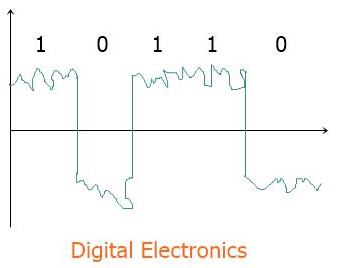- Digital Electronics Course
- Digital Electronics Tutorial
- Logic Gates
- NAND NOR as a Universal Gate
- Boolean Algebra
- Proof of Theorems and Postulates
- De-Morgan's Theorems
- Duality Principle
- Sum of Products (SOP)
- Product of Sum (POS)
- Canonical SOP Form
- Canonical POS Form
- SOP to Standard SOP
- POS to Standard POS
- Standard SOP to Minimal SOP
- Standard POS to Minimal POS
- Computer Programming
- Learn Python
- Python Keywords
- Python Built-in Functions
- Python Examples
- Learn C++
- C++ Examples
- Learn C
- C Examples
- Learn Java
- Java Examples
- Learn C#
- Learn Objective-C
- Web Development
- Learn HTML
- Learn CSS
- Learn JavaScript
- JavaScript Examples
- Learn SQL
- Learn PHP
Digital Electronics Tutorial
This "digital electronics" course is intended for those who are new to the field or want to improve their existing knowledge. This course is primarily intended for beginners. So, without further ado, let us begin the course with its definition 😊.
What are digital electronics?
The term "digital electronics" refers to the branch of electronics that studies digital signals and the design of electronic devices that process data digitally. In other words, we can say that "digital electronics" are any electronics that operate on a digital signal.
Everything in the modern era is filled with digital electronics. For example, if you are learning about digital electronics on your mobile phone or computer system by using this website, codescracker, it means you are using a digital system to gain some knowledge about the field of digital electronics. Digital electronics includes all electronic devices that use digital signals (such as mobile phones, laptops, scanners, printers, keyboards, and so on). Another example of digital electronics is monitoring real-time data with your system.
Only with the invention of ICs, or integrated circuits, is it possible to create and build our world in digital form.
With the invention of ICs, our world is rapidly expanding and advancing in technology through the use of digital electronics.

Please ignore the terrible illustration and pay attention to the signal, which is a digital signal. The signals can be compared to electrical voltage, with a high voltage representing a signal with a value of 1 and a low voltage representing a signal with a value of 0.
In digital electronics, circuits are constructed using massive arrays of logic gates. You can read a dedicated article for more information on logic gates.
Digital Electronics: Types of Signal
As we all know, there are two types of signals available, as given below:
- Analog signal
- Digital signal
The analogue signal can also be called a "continuous signal," and the digital signal can also be called a "discrete signal."
In this section, we will only discuss the digital signal, which has two values: high or low."High" means 1 and "low" means 0. Here is the representation of the digital signal:

As already stated, 1 represents a high value, and 0 represents a low value. given that 0 and 1 are the only valid states for digital signals.
The representation that was just presented can also be shown as:

The Primary Benefits of Digital Signal
The main or primary advantages of using a digital signal over an analogue signal are:
- It is smaller in size.
- It develops or creates improvements in technology.
- It is easy to design.
- It is cheaper.
- It creates less noise, interference, and distortion.
Examples of digital electronics
Here are some of the main examples of digital electronics:
- mobile phones
- computer systems
- electronic-readers
- laptops
- flash drives
- scanners
- mice
- printers
- keyboard etc.
All the devices listed above are examples of digital electronics, as they operate on digital signals.
Audience Message
Students who are required to learn digital electronics or who are interested in learning about digital electronics are the target audience for this course, which is designed to cover only the most important topics of digital electronics and provide as much information as is possible.
This tutorial has been broken up into the following articles so that you can learn about all of the popular and important topics in digital electronics one by one.
- Logic Gates and its Types
- Why NAND and NOR gates are called universal gates
- Boolean Algebra in Digital Electronics
- Proof of all Theorems and Postulates of Boolean Algebra
- De Morgan's Theorem of Boolean Algebra
- Duality Principle in Boolean Algebra with Examples
- Sum of Product (SOP) Form
- Product of Sum (POS) Form
- Canonical SOP Form with Examples
- Canonical POS Form with Example
- Convert SOP to Standard SOP Form
- Convert POS to Standard POS Form
- Convert Standard SOP to Minimal SOP form
- Convert Standard POS to Minimal POS form
Prerequisites
You can start learning digital electronics here without any prior knowledge, as it is not compulsory to have any prior knowledge about anything before starting the tutorial. But if you have some basic skills about computer fundamentals and the computer number system, then you will find it easier to learn the topics given here. Otherwise, you can start learning; later, you will understand all the things given here.
« CodesCracker Home Next Tutorial »